This spectacular stove deserves its own post.
Claude Monet’s house in Giverny has a collection of copper cookware that I examined in a separate post, but this giant stove is a showstopper.
This is a fourneau économique, a multi-function kitchen stove made of cast iron (fonte) and sheet metal (tôle). These appliances began to appear in French kitchens in the early 19th century and represented a huge advance in convenience in the kitchen. Cora Millet-Robinet (1798-1890) writing in La maison rustique des dames (10th ed., 1877, vol. 1) extols the benefits:
They make cooking much easier, allow the table service to be kept warm, and portions for the servants, and no animal can ever touch the food there because the cast iron is always too hot for their paws.
 Prior to the emergence of the fourneau économique, French cooks used kitchen hearth coals in a potager such as the one shown at right — a wood and masonry stove composed of a series of shallow grills that used embers from the kitchen hearth. The fourneau économique, in contrast, maintained a single intense fire burning in an interior combustion chamber called a foyer. Millet-Robinet notes that a cook habituated to a potager might not immediately embrace this new type of stove:
Prior to the emergence of the fourneau économique, French cooks used kitchen hearth coals in a potager such as the one shown at right — a wood and masonry stove composed of a series of shallow grills that used embers from the kitchen hearth. The fourneau économique, in contrast, maintained a single intense fire burning in an interior combustion chamber called a foyer. Millet-Robinet notes that a cook habituated to a potager might not immediately embrace this new type of stove:
When a cast iron stove is first installed in the kitchen, there is almost always strong resistance from the cook who is not used to it, but soon she learns to use it, and finds it so easy that she adopts it with pleasure.
Says Millet-Robinet, the most compelling advantage of a fourneau économique over a potager is that the single consolidated heat source is much easier for the cook to manage.
They only have one foyer to maintain, whereas to cook the same quantity of preparations on an ordinary stove, it would be necessary to fill several holes with fire, and, in addition, to maintain the fire in the fireplace, which, in addition to its usual purpose, must also be sufficient to provide embers for the pot lids.
Perhaps this practical argument was persuasive for Claude Monet as well. He lived in the house from 1883 until his death in 1926 and was known for his enjoyment of food; a fourneau économique would doubtless have made it easier for his beloved cook Marguerite to prepare the excellent luncheons where he entertained patrons, fellow artists, and politicians.

Monet’s stove carries a badge on the front that reads:
MON BRIFFAULT
G. DROUET
SUCr de E. LOISEAU DROUET et Cie
CONSTRUCTEURS Btes SGDG
74 AVENUE PARMENTIER PARIS
This identifies this stove as the work of Maison Briffault, one of the finest stove manufacturers in Paris. According to a feature story in the April 1875 edition of Le Panthéon de l’industrie, Maison Briffault can trace its history to a metalworking company founded in 1845 at Rue de Buisson-Saint-Louis. (Unfortunately, despite my best efforts, I can’t figure out what that earlier company was named.) In 1861, Jean Louis Briffault des Corrières (b. 1828, d. circa 1898) assumed direction of the company and by 1863 the firm was listed as Briffault des Corrières, 7 Passage de Buisson-Saint-Louis. In 1873, the firm expanded and relocated to 31 Rue de la Roquette and 8 and 14 Rue Saint-Sabin. I believe that it was around this time that the company began to use the name “Maison Briffault.”
 Paris in the 1870s was the industrial innovation center of France and Jean Louis was a talented engineer. Among many competitors, he distinguished his stoves with two key innovations highlighted in a feature story in the April 1875 edition of Le Panthéon de l’industrie:
Paris in the 1870s was the industrial innovation center of France and Jean Louis was a talented engineer. Among many competitors, he distinguished his stoves with two key innovations highlighted in a feature story in the April 1875 edition of Le Panthéon de l’industrie:
This stove, whose length varies from 1m 05cm to 1m 53cm, is first distinguished by a cendrier trieur (ash filter), that is to say a mesh placed under the fire compartment, which lets the ash escape and retains the smallest particles of coke. This cendrier trieur provides, without any effort by the cook, a saving of 25% on fuel.
Coal was expensive and a stove could burn through hundreds of pounds each month. Recovering usable pieces that would otherwise have been tossed out with the ashes would be a key selling point to offset the expense of a stove like this.
Jean Louis Briffault’s second innovation was a new design for a grillade rôtissoire, a roasting grill.
In addition to this improvement, Mr. Briffault’s nouveau fourneau économique contains a grillade rôtissoire that has absolutely nothing in common, neither in form nor in the results it produces, with the classic grills which are fitted in almost all stoves.
The grilling of the nouveau fourneau économique leaves no odor or smoke. It is placed beneath the fire, which is maintained in a continual state of incandescence by skillfully managed currents of air. The coal is placed on a kind of iron sieve through which the heat passes freely but which retains absolutely all the ash. A receptacle placed under the grill receives the fat and juice from the meat.
Meats and fish cooked using this grillade rôtissoire take on a beautiful golden color and never pick up the taste of burnt fat or smoke, which cannot be entirely avoided in ordinary grills.
Thanks to the company’s 1887 catalog, we have clear directions on how to operate this innovative upside-down rôtissoire grillade:

HOW TO USE THE GRILL SET BELOW THE FIRE
- One may use wood embers or charcoal. Charcoal is best.
- With the key to the chimney open, light the coal in the stoves, close the baffles and open the door on the front.
- When the coals are well lit, if the draft is too strong, moderate it using the flue key.
- Place the meat or fish on the grill in the leche-frite (drip pan). For dark meats: beefsteak, chops, entrecôtes, place the leche-frite on the highest notch; for white meats, to the 2nd notch, for fish, to the 3rd notch and then raise it to intensify the cooking.
- During the entire cooking process, do not stir the charcoal and if you need to rearrange it or add more, remove the leche-frite and put it back in immediately.
Note — Pork chops grill in 6 minutes, beefsteaks in 8 minutes. — A chicken roasts in 30 minutes.
Briffault’s innovations were commercially successful and the firm took on additional partners. In 1880, E. Loiseau joined the enterprise to form “Briffault & Loiseau,” though the company continued to go by “Maison Briffault” and “Briffault des Corrières” for a few more years.
Then in 1888 came another partner, Georges Drouet, and while advertisements for the firm continue to call it “Maison Briffault,” the legal name of the company became “E. Loiseau, Drouet et Cie,” suggesting that Jean Louis had stepped away from the firm. By then he was sixty years old and I suspect he was ready to retire; his wife Antoinette had passed away in 1866 at the age of thirty, the same year as the birth of their daughter Blanche Antoinette, who herself died at the age of twenty in 1886. Jean-Louis lived for another ten years and passed away circa 1898.
But the successful and well-established Briffault brand lived on and the enterprise prospered under the leadership of Georges Drouet. The company was listed as “Briffault (maison) (E. Loiseau Drouet et Cie successeurs)” for at least two years, but starting in 1890 the association with Loiseau appears to have fallen away and the company was under the direction of “(G. Drouet succ.)”. Georges Drouet appears to have been not simply a clever manufacturer but also a canny marketer: Briffault’s 1890 catalog opens with a lovely frontispiece suggests the turning of pages from the primitive era to the hearth cooking era and then, with the next page, to the glorious present day of modern industrialization.


That 1890 catalog gives us an idea of how these stoves were integrated into kitchens of different types.



The company continued to prosper and around 1891 moved once more to 74 Avenue Parmentier, expanding in 1896 into the adjacent property at number 72 as well. It is at this time that I begin to see Briffault listed not simply as provider of chauffage (heating) and fourneaux économiques (home kitchen stoves), but also under articles de ménage (household goods) and batterie de cuisine en cuivre (copper cookware). (Please see this 1897 Briffault catalog for the company’s cookware offerings.)
The company’s identification on invoices during this time period was as “Maison Briffault, G. Drouet, successeur E. Loiseau Drouet et Cie” until at least 1901. But advertisements such as the one below, dated 1895, did not mention Drouet or Loiseau at all.


Martin was able to identify some prominent customers of this era: “Amongst Briffault’s clients was the Hotel Meurice in Paris, the Imperial Hotel in Nice, the Grand Duchess Xenia in St Petersburg, the Château de Modave in Belgium, and Baron de Zuylen and his wife Hélène de Rothschild at the Château de Haar in Holland. The couple had this chateau rebuilt (1892-1907) by the architect Pierre Cuypers, who equipped it with a superb Briffault kitchen with a very complete set of hammered copper cookware. Open to the public since 2016, the château has kept this fabulous cuisine and all its Briffault copper ware, including large oven roasting pans so very similar to this one.”
In 1903 the company filed the paperwork to form a société anonyme — a shareholder-owned company — in the name of Compagnie Française des Fournaux Briffault. (George Drouet’s son Georges-Alfred continued as general director.) After this point, the firm was no longer known as “Maison Briffault” but instead as “Fourneaux Briffault.” I reviewed a number of Briffault receipts and other business ephemera of that period and by 1907 the company was representing itself as Société Anonyme Forneaux Briffault.
Astonishingly, the company continued to operate at 72-74 Rue Parmentier into the 1960s (and perhaps well after that) with a specialty in gas stoves and portable propane tanks. By the 1980s the firm was evolving away from consumer gas appliances and into manufacturing for the natural gas industry, and in 2001 was acquired by the Italian firm Pietro Fiorentini. Today Briffault operates as a part of Gazfio, a gas engineering and distribution firm in Normandy. The company today is quite changed from its origins in Paris but still recalls with pride the legacy of the Briffault name.
Identifying Monet’s stove
I have found no information establishing when Claude Monet purchased this stove for his household, but I will venture a guess based on the information on the plaque on the front and my amateur research. The plaque specifies the 74 Avenue Parmentier address that came into use in 1891, but does not mention the adjacent 72 Avenue Parmentier property acquired in 1896. The plaque reads “G. Drouet, successeur E. Loiseau Drouet et Compagnie” and I see commercial ephemera dated 1899 with that same notation. Taken together, these data points suggest to me that the plaque — and presumably the stove to which it was attached — was made after 1891 and likely prior to 1896, but no later than 1903 when the company became a société anonyme.

I am fairly confident that Monet’s stove is a fourneau à grillade et 2 réchauds avec four à pâtisserie, a design available in the 1890s but shown in best detail on page 95 of the lovely Briffault catalog of 1909.

Here are the features of this stove:
- 1 four à retour de flamme
- 1 étuve
- 1 chauffe-assiettes
- 1 four à pâtisserie avec foyer spécial et étagères mobiles
- 1 grillade lyonnaise à triple départ
- 2 réchauds à charbon de bois avec cendrier
- 1 chaudière avec robinet
- 2 cendriers dont 1 trieur
Let’s take a close look at how this stove functions. Chapter 6, Appareils d’économie domestique et accessoires (“Domestic household apparatuses and accessories”) of Traité pratique de fumisterie, chauffage, ventilation et chaudronnerie concernant le bâtiment (“Practical treatise on fumigation, heating, ventilation, and boilermaking related to construction”) by V. Maubras, published in 1908, explains each of these features in great detail.
 A stove such as this is a metal shell around a series of compartments and ducts. The heart of the stove is the foyer, the combustion chamber. Coal (charbon or charbon de terre), coke (heat-treated coal that burns hotter and cleaner), or wood charcoal (charbon de bois) burns in the foyer to produce heat that conducts and convects throughout the structure. Air intake is controlled by vents, and the combustion products — smoke and hot fumes, in French termed collectively flamme — travel through interior ducts to escape via the tuyau de fumée (chimney pipe) at the rear of the stove. The foyer has a grill at the bottom so that ashes can fall away; below each foyer is always found at least one cendrier, a removable tray or container to catch the cendres (cinders).
A stove such as this is a metal shell around a series of compartments and ducts. The heart of the stove is the foyer, the combustion chamber. Coal (charbon or charbon de terre), coke (heat-treated coal that burns hotter and cleaner), or wood charcoal (charbon de bois) burns in the foyer to produce heat that conducts and convects throughout the structure. Air intake is controlled by vents, and the combustion products — smoke and hot fumes, in French termed collectively flamme — travel through interior ducts to escape via the tuyau de fumée (chimney pipe) at the rear of the stove. The foyer has a grill at the bottom so that ashes can fall away; below each foyer is always found at least one cendrier, a removable tray or container to catch the cendres (cinders).
Monet’s stove has 2 cendriers dont 1 trieur, meaning that it has two stacked cendriers positioned under the foyer. The upper cendrier has the trieur so that fine ashes fall through to the second cendrier below to be removed. (Recall that this was specified as one of Briffault’s innovations.) According to Maubras, the door of the upper cendrier has a door à tourniquet or à papillon (butterfly) with adjustable vents to adjust air flow to the flame in the foyer above, while the lower cendrier has a solid door to contain the fine ashes. (I suspect the two cendriers on Monet’s stove have been inverted — if the one with the vented door is a cendrier à trieur, it should be positioned above the other one.)
A stove with a primary foyer that takes wood or wood charcoal (or a combination of wood and coal) as its fuel source would have a door on the façade to feed it, but Monet’s stove has a coal-fired primary foyer, which means that it is fed from above through a large opening in the stove’s top surface.
The cast iron top of the stove has, as can be seen, a removable piece of cast iron of oval shape that is referred to as a connection plate or more correctly a coup-de-feu. Generally its thickness is greater than that of the top surface because it is directly in contact with the heat.
 This coup-de-feu surrounds smaller circular disks called rondelles. According to Maubras, the foyer is mounted just 5 or 6 centimeters below the stove surface, and so the rondelle directly above the foyer receives the most intense direct heat of any part of the stove.
This coup-de-feu surrounds smaller circular disks called rondelles. According to Maubras, the foyer is mounted just 5 or 6 centimeters below the stove surface, and so the rondelle directly above the foyer receives the most intense direct heat of any part of the stove.
The center of the rondelle (called the tampon, or plug) has a small depression with a crossbar; the cook uses an iron rod called a crochet with a hook at one end to lift it out. Additional rondelle rings could be removed as needed so that saucepans or pots of various sizes could be lowered partially into the interior of the stove for more direct exposure to the foyer or the circulating flamme. Millet-Robinet says that flat-bottom jam pans were heated this way to make preserves.
You can, by removing all the discs from one of the holes, place a cauldron or a basin of sufficient size to melt fats, butter, cook preserves using the Appert process, or make jams.
I believe some pots and pans were manufactured with a flange running around the perimeter for this exact purpose. Below at left is a Briffault stove configured for a removable stewpot; at right is a saucepan with a “skirt” (thanks to Martin for finding this example).



In addition to its two rondelles, Monet’s stove also has surface compartments called réchauds (warmers) with inset grills that could serve as a second heat source independent of the foyer. A réchaud does not use coal but instead burns a small quantity of charbon de bois (wood charcoal) or braises (burning embers from the kitchen hearth), similar to the grill of a potager. 
Réchauds were available as single units (simple), side-by-side (double) as shown at right and on Monet’s stove, or as one long rectangular réchaud-poissonière.
In addition, the cook could convert rondelles into réchauds via drop-in units as shown below, again from Briffault’s 1887 catalog. The description reads, “for transforming coal stoves to fourneaux d’été (summer stoves) or for the use of wood charcoal.”

This convertibility into a fourneaux d’été is the solution to the problem of how a coal-fired stove that became murderously hot could remain usable during summer weather: instead of firing up the foyer, use the surface réchauds as individual burners. The shallower réchaud du four is sized to slide into the narrow gap just above the oven, while the deeper réchaud du foyer is for the more spacious opening above the (presumably empty) coal compartment and offers two interior grills to set the food closer to or further from the hot charcoals in its base. The vents in the upper sidewalls of the réchaud provide ventilation into the interior of the stove, ensuring that smoke and fumes area drawn into the stove and out the chimney instead of flowing into the kitchen.
In the center of the top surface of Monet’s stove is a chaudière avec robinet, a rectangular water container with a brass lid called a panache and a drain pipe leading to a faucet (robinet) set in the front of the stove. The chaudière serves as a source of hot water for the household but the system appears to have been a little finicky: “It goes without saying that the [water] tank should never be left empty when the stove is in use,” cautions Maubras, “because then it would be put out of order very quickly. This is also one of the main causes of wear and tear on tanks and it is only attributable to the negligence of servants.”

Monet’s stove has two fours and one étuve. In English these terms translate as the same word — “oven” — but in French they have distinct meanings: A four is a high-temperature oven for roasting and baking, whereas an étuve is a lower-temperature oven for keeping cooked food warm, proofing dough, and other tasks that do not require intense heat. In stoves like Monet’s that are equipped with both types of oven, the two ovens are set one on top of the other, with the four above and the smaller étuve below.
Says Maubras,
The four a rôtir (roasting oven)… is made up of a more or less thick sheet metal box (1 or 2 mm) in which there is a movable shelf… placed parallel to the floor of the oven. The four is riveted to the sheet metal façade, and its floor is removable so as to allow the top of the étuve to be swept and the removal of the soot, which will fall when carried away by the current of hot gases.
In addition, the four à rôtir has a slender sliding vent called a coulisse d’évaporation which can be opened during cooking to allow fresh air to flow into the oven.
The role of this sliding vent is to allow the vapors and moisture which are released from the food in the oven to escape through the chimney. If, in fact, this slide is open, the vacuum created by the draft will draw in the vapors and moisture which will mix with the hot gases, without their odor spreading throughout the kitchen, which is always unpleasant.
(I see a coulisse d’évaporation on Briffault’s design but not on Monet’s stove, and I’m not sure why. It seems like a useful thing to help crisp the skin of a roast or the crust of a gratin.)
The four in Monet’s stove is an advanced type of oven called a four à retour de flamme. The interior of the stove and the placement of the chimney are engineered to draw the flamme (heat, smoke, and fumes, not actual flames) from the foyer to flow in a directed current around the oven compartment to increase the heat transfer. Says Maubras,
The flamme and hot gases pass over the top of the four, go down to the [right side], lick the bottom and also heat the underside of the chaudière before going into the chimney, which is fitted with an adjustment valve. […] The heat is, in this case, much more energetic; [the four] is in fact heated on all its sides; because the [left] side directly receives the radiation from the foyer, it becomes red hot in no time.
The diagram below shows how this air circulation is achieved in a stove with twin fours à retour de flamme, a configuration called a fourneau à double service. (Monet’s stove is a fourneau à simple service with a single four, but the same concept applies.) Heat from the foyer (a) must travel a circuitous path around the fours (f1 and f2) to reach the chimney intakes (c1 and c2). In this way the upper, side, and lower surfaces of the fours were exposed to convective heat from the flow of heated air as well as radiant heat from proximity to the red-hot foyer walls. The smaller oven compartments labeled e1 and e2 are lower-temperature étuves with direct exposure to the flamme only on their upper wall. (Seeing this diagram, I better understand why the floor of the four is removable to access and clean away the soot that would have come to rest on the étuve beneath.)

Monet’s stove has a second oven called a four à pâtisserie designed to sustain steady heat for baking. According to Maubras, this oven was “lined externally with refractory briquettes” with a floor “made up of a fairly thick cast iron plate” for heat retention. It was not heated by the stove’s primary coal foyer but rather by its own foyer spécial fed from a door on the façade of the stove.
The pastry oven is specially equipped with a foyer that can burn wood, coal, or coke, at the convenience of the person using it. The smoke and hot gases surround the sides of the oven and are reunited at the top before joining the chimney, which is divided into two parts… so as to separate the smoke from the stove and the pastry oven. It goes without saying that the flues for these two chimneys are distinct inside the stove.
 Unlike the primary foyer that is fed coal from above, the foyer spécial is fed coal, coke, or wood through a door on the front into an interior foyer à bois open at one end. I don’t know why the primary foyer à charbon was not also made as conveniently accessible; perhaps there was too great a risk of coal tumbling out. Readers, do you know?
Unlike the primary foyer that is fed coal from above, the foyer spécial is fed coal, coke, or wood through a door on the front into an interior foyer à bois open at one end. I don’t know why the primary foyer à charbon was not also made as conveniently accessible; perhaps there was too great a risk of coal tumbling out. Readers, do you know?
Monet’s stove also has a chauffe-assiettes, a plate warming compartment opening to the front. Says Maubras, “The chauffe-assiettes is a large étuve with multiple shelves and no coulisses [front sliding vents].” This chauffe-assiettes is positioned in the lower left area of the stove and is relatively far from the primary foyer, but the stove’s iron structure apparently conducts and radiates enough heat to maintain a steady low heat in this side compartment.
One element of Briffault’s design that Monet’s stove appears to be missing is the grillade lyonnaise. A grillade is a hood over a grill to create a draft to draw smoke and fumes up into the stove’s chimney; a door on the front slides down to form a sort of seal around the grill area to intensify the draft. A simple grillade sits on top of a stove’s réchauds whereas a grillade lyonnaise has its own rectangular grill set in a removable tray above a shallow cendrier.

Briffault’s design for Monet’s stove places the grillade on the right end of the stove on the flat surface above the four à patisserie. (That’s why it’s a grillade lyonnaise — there is not enough clearance above the four à pâtisserie for inset réchauds.) I don’t know why Monet’s stove does not have a lyonnaise — was it removed at some point, or did Monet delete it from his order?
 With all this information — and with the page at right from the 1877 catalog, which helpfully identifies each type of door — we can confidently identify the components of Monet’s stove.
With all this information — and with the page at right from the 1877 catalog, which helpfully identifies each type of door — we can confidently identify the components of Monet’s stove.
I see a few possible customizations — most notably the absence of the grillade lyonnaise, but also what looks like an additional cendrier below the foyer spécial in the lower left area. The pipe projecting up the back wall and over the chaudière is a fresh water dispenser, a clever addition for the convenience of the cook. (I suspect that the twin cendriers have been switched — if the one with the vented door is indeed the cendrier à trieur, it should be positioned above the one with the solid door, not beneath it as in the photo.) Note how the chimney is wider at the base and tapers to a narrower diameter — this is to accommodate the separate flues of the primary foyer and the second foyer spéciale, which appear to merge right around the seam in the chimney’s surface.

Take a moment and imagine you were Monet’s beloved cook Marguerite, the chef of this kitchen. Every morning the stove must be fueled and managed for the day according to the meals you have planned. I have never used a stove like this, but it seems to me that once the coal fire was burning, reloading the foyer would entail handling the single hottest item on the entire stove — the rondelle and coup-de-feu directly above it. Even with the assistance of the iron crochet, this still seems like a perilous task! You would need to fire up the stove strategically so that its heat was timed optimally and you didn’t need to reload it right in the middle of cooking.
As the cook, your job would be to learn over time and experience how feeding and adjusting airflow to each foyer affects the temperature of the stove’s various compartments and surfaces, and then to adapt your cooking technique accordingly. (I imagine readers with an Aga or other fixed-heat oven are accustomed to this!) Heat for the cooktop was either quite intense from the coal-fired foyer or relatively gentle from the charcoal in the réchauds. The rondelle directly above the foyer would be as hot as the coal could make it; the second rondelle would be slightly cooler but still well-heated by the flamme passing underneath.
 Trying a new recipe would be a process of trial and error. The steadiest heat on the stovetop was also the most intense and the most difficult to adjust. If you wanted gentler heat, you would have to set up one of the réchauds with charcoal and keep feeding and watching it to maintain its temperature. And of course you did not have a thermometer or thermostat, so you had to judge temperature by observation alone. Cookbooks up into the mid-19th century don’t specify cooking times or temperatures but rather how to judge cooking progress by sight, smell, or touch — you could read these descriptions, of course, but you’d learn to do this yourself through experience. Considering all the variables involved with cooking each meal, you would not just need to learn how your stove worked — you’d need to form a real working partnership. (Perhaps it was something like the image at right from Briffault’s 1915 catalog — “Her good friend!”)
Trying a new recipe would be a process of trial and error. The steadiest heat on the stovetop was also the most intense and the most difficult to adjust. If you wanted gentler heat, you would have to set up one of the réchauds with charcoal and keep feeding and watching it to maintain its temperature. And of course you did not have a thermometer or thermostat, so you had to judge temperature by observation alone. Cookbooks up into the mid-19th century don’t specify cooking times or temperatures but rather how to judge cooking progress by sight, smell, or touch — you could read these descriptions, of course, but you’d learn to do this yourself through experience. Considering all the variables involved with cooking each meal, you would not just need to learn how your stove worked — you’d need to form a real working partnership. (Perhaps it was something like the image at right from Briffault’s 1915 catalog — “Her good friend!”)
The next time you twist the knob on your cooktop or dial in a temperature on your oven, reflect for a moment on what a revolution those conveniences represent. I can usually replicate a recipe with reasonable success on the first attempt, thanks to modern techniques to generate, measure, and moderate heat with precision. By comparison, cooking with Monet’s stove would be equal parts experiment and artistry. I don’t know about you, but I have a newfound respect for the men and women who, day after day, rolled up their sleeves and got to work!
Readers, I hope you have enjoyed this post, which is a little eccentric to the stated purpose of VFC. Have you had the opportunity to work with a Briffault stove or another of the same period or design? If you work with a modern fixed-heat stove such as an Aga, how do you adapt recipes? And if you cook on such a stove with copper, do you find it performs differently than with pans of other material?
One last thing…
The Fondation Claude Monet does a wonderful job protecting and maintaining this kitchen, but I have one suggestion for them: flip over the rondelles, because I think they’re upside down! The photos below show a bump at the center of each rondelle and a corresponding mark on the base of certain saucepans in the copper collection. That bump should be on the underside — turn those rondelles over and the surface will be flat. If you know anyone at the Fondation Claude Monet, please pass along the friendly suggestion to flip the rondelles the right way around!


References
Cora Millet-Robinet was a fascinating woman and a skilled author and I enjoyed reading La maison rustique des dames. It was first published in 1844 and reprinted in at least eleven editions into the 1880s. For this post I drew from the 10th edition, Volume 1, Chapter VII, De la maison de maitre et de son mobilier, and specifically the section Cuisine beginning on page 77. The 10th edition, published 1877, was the very earliest edition of volume 1 I could find to read for free online. (Volume 2 is available in much earlier editions but the information I was looking for is not covered in that part.) If you are able to find an earlier edition of volume 1 available online, please do let me know, as I’d be interested in seeing if her information and advice on fourneaux économiques was updated.
Traité pratique de fumisterie, chauffage, ventilation et chaudronnerie concernant le bâtiment (V. Maubras, Paris, 1908) was absolutely crucial to this post, as you can see by the many quotes and diagrams I have used pulled from it. There is not much information out there on Monet’s stove and what there is appears to be a bit unreliable; I am very fortunate that I was able to find a contemporary technical resource with such detail. Once again, the Bibliothèque National de France is performing a great service to us all by digitizing and sharing these primary source documents.
I’ve brought in a few Briffault catalogs for your perusal. There are of course many more Briffault catalogs from later in the 20th century but I’m focused on the 1880s to early 1900s for this post. (Thanks as always to Ultimheat for capturing and sharing these — I copy these over to VFC to relieve Ultimheat of the financial burden of hosting and sharing these large PDFs, but not out of any attempt to claim credit for them.)
- 1887 Briffault-Loiseau
- 1890 ca Briffault
- 1895 Briffault
- Briffault 1897
- 1898 Briffault
- 1904 Briffault
- 1909 Briffault
- 1909 Briffault Album (extensive)
That long 1909 Briffault Album in particular is a treat. The first twenty pages or so are marketing material about the company’s state-of-the-art metalworking facilities, and though my personal interest is in copper cookware and not metal products in general, I found the diagrams and descriptions of the machinery to be quite useful. I spend a lot of time on this site trying to assess how old a piece of copper cookware might be based on what I can observe about how it was made, and a lot of that is speculation based on what machinery could or could not have been available at the time. This catalog goes into some detail on the enormous gas-fueled metal cutters, presses, and rollers in use at Briffault in 1909 and for our purposes is a snapshot of a high-volume, financially successful ironmongery of the period. I am reasonably comfortable extrapolating that the same level of technology was available for the copper cookware industry as evidenced by what I see in pieces of the time: thick-gauge copper, machine-cut blanks, seamless deep-drawn pieces of increasing depth, and so on. But imagine the cost of buying and operating all this machinery! I also interpret this catalog as additional evidentiary support for my Great Consolidation hypothesis, which is that many small family chaudronneries of the 19th century closed up or sold themselves off because they couldn’t afford to transition to machine-based manufacturing. The 20th century would belong to the firms that survived that transformation: Gaillard, Jacquotot, Dehillerin, Legry, Meret Frères, Mauviel, and so forth. Paging through the 1909 Briffault catalog, I get a glimpse of how this exciting new era must have been.
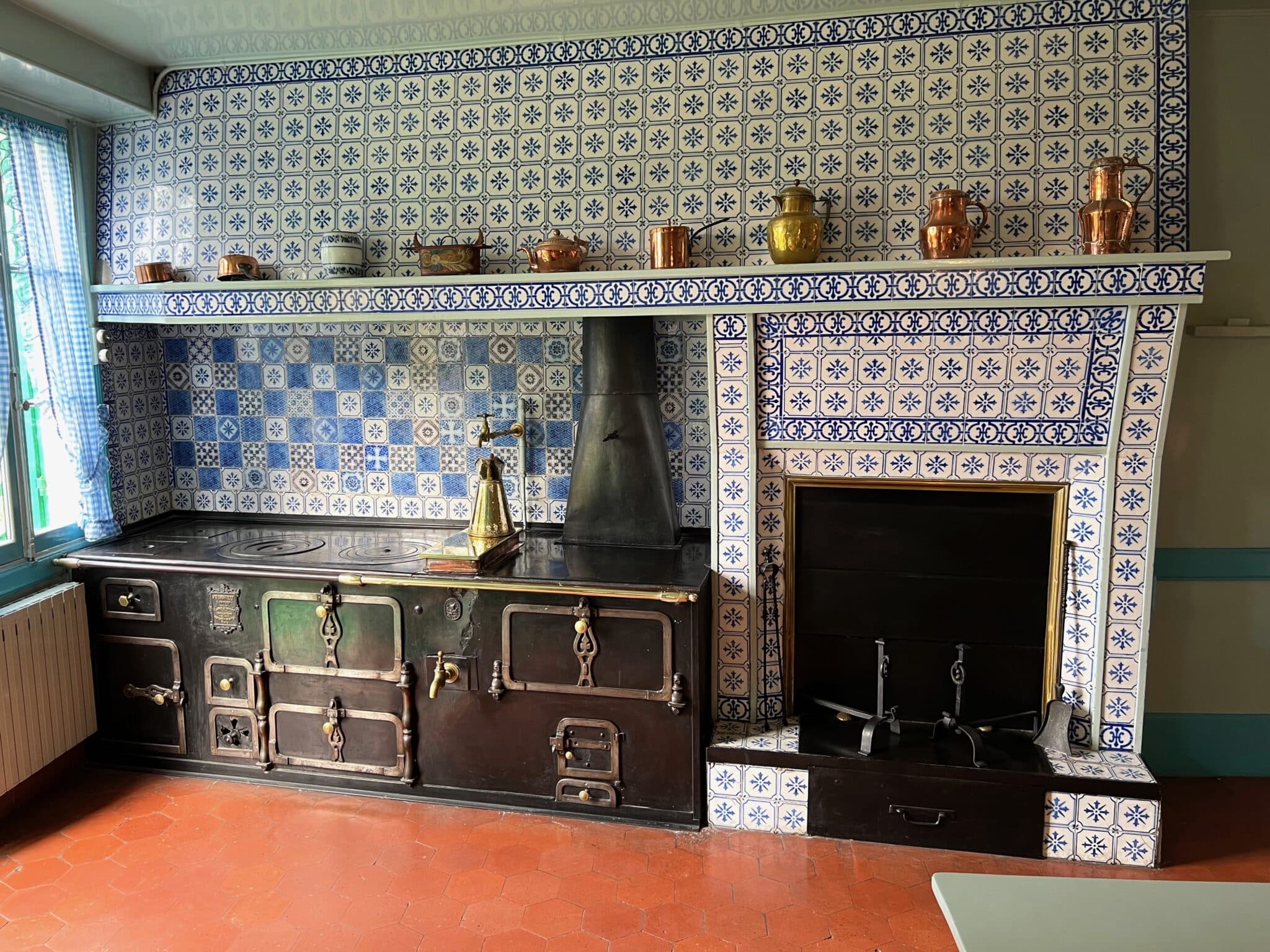
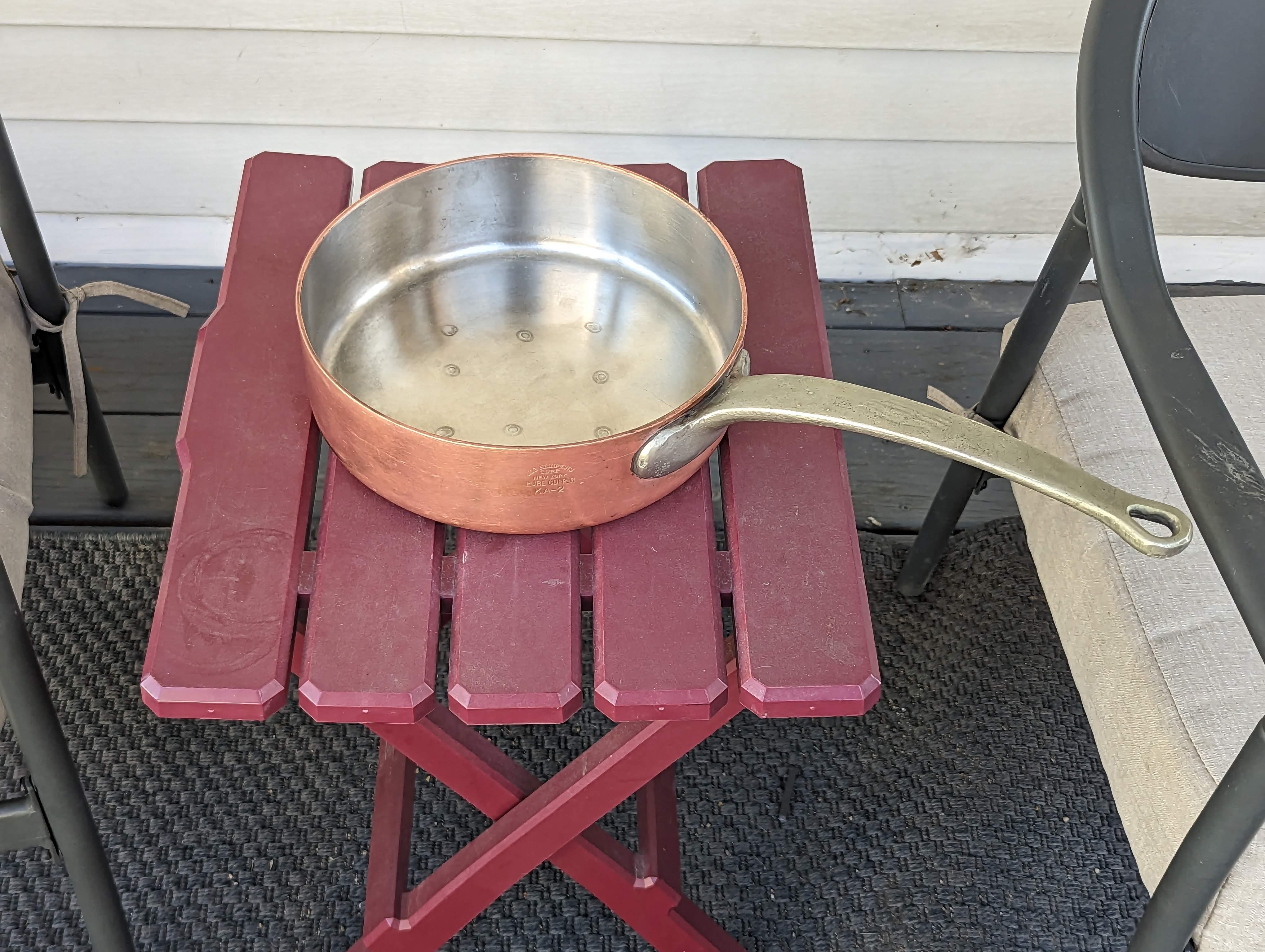
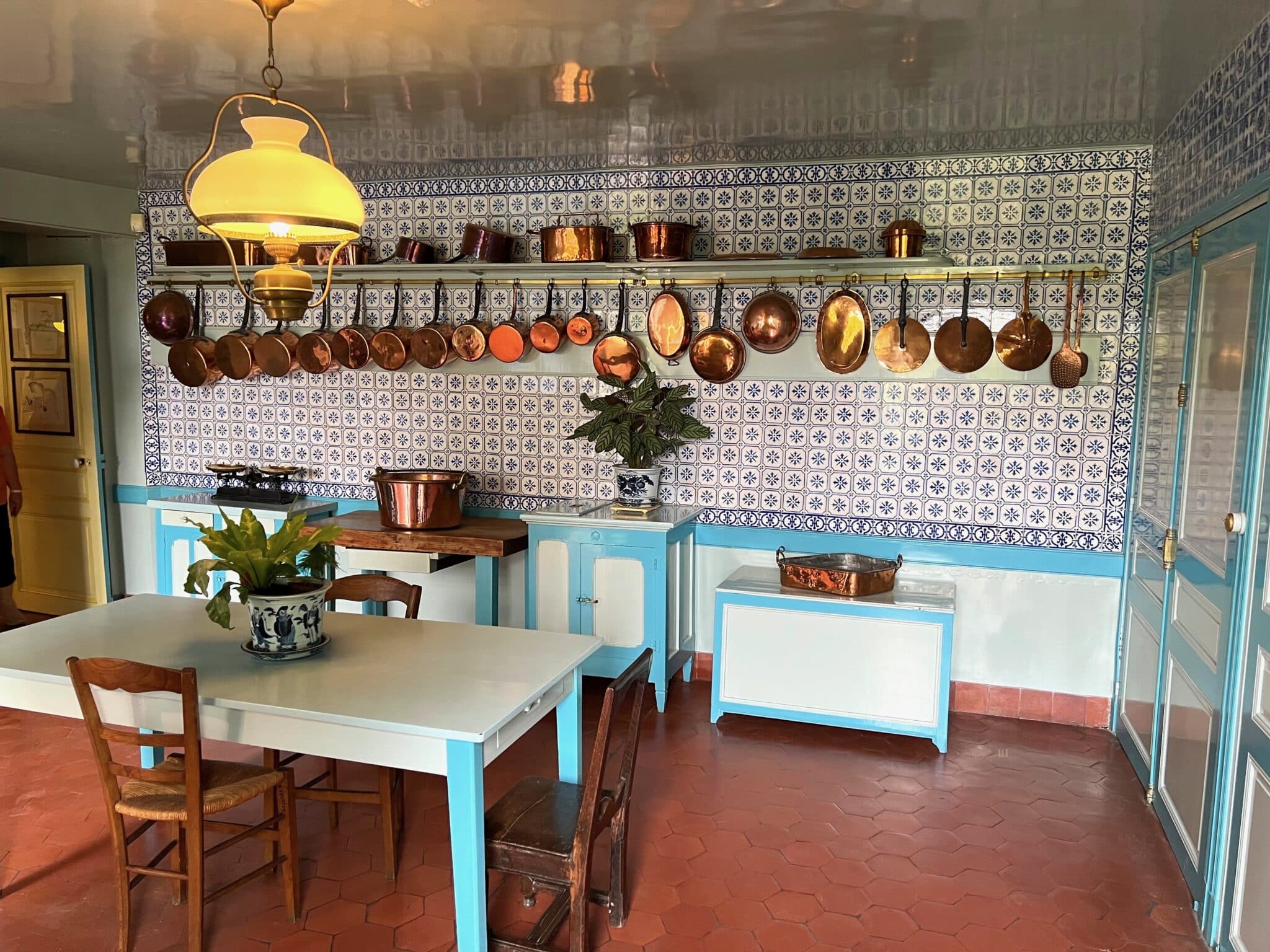
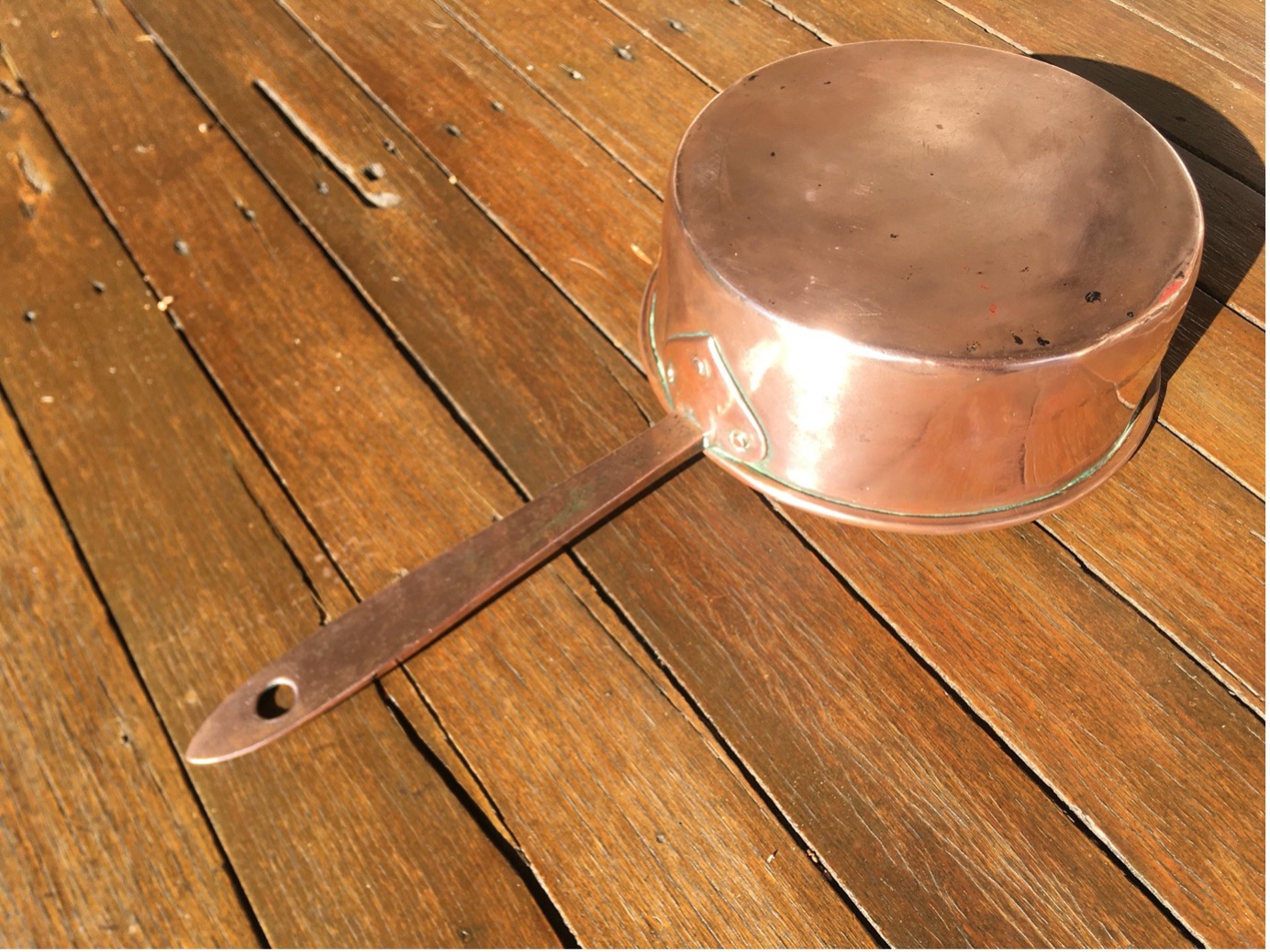
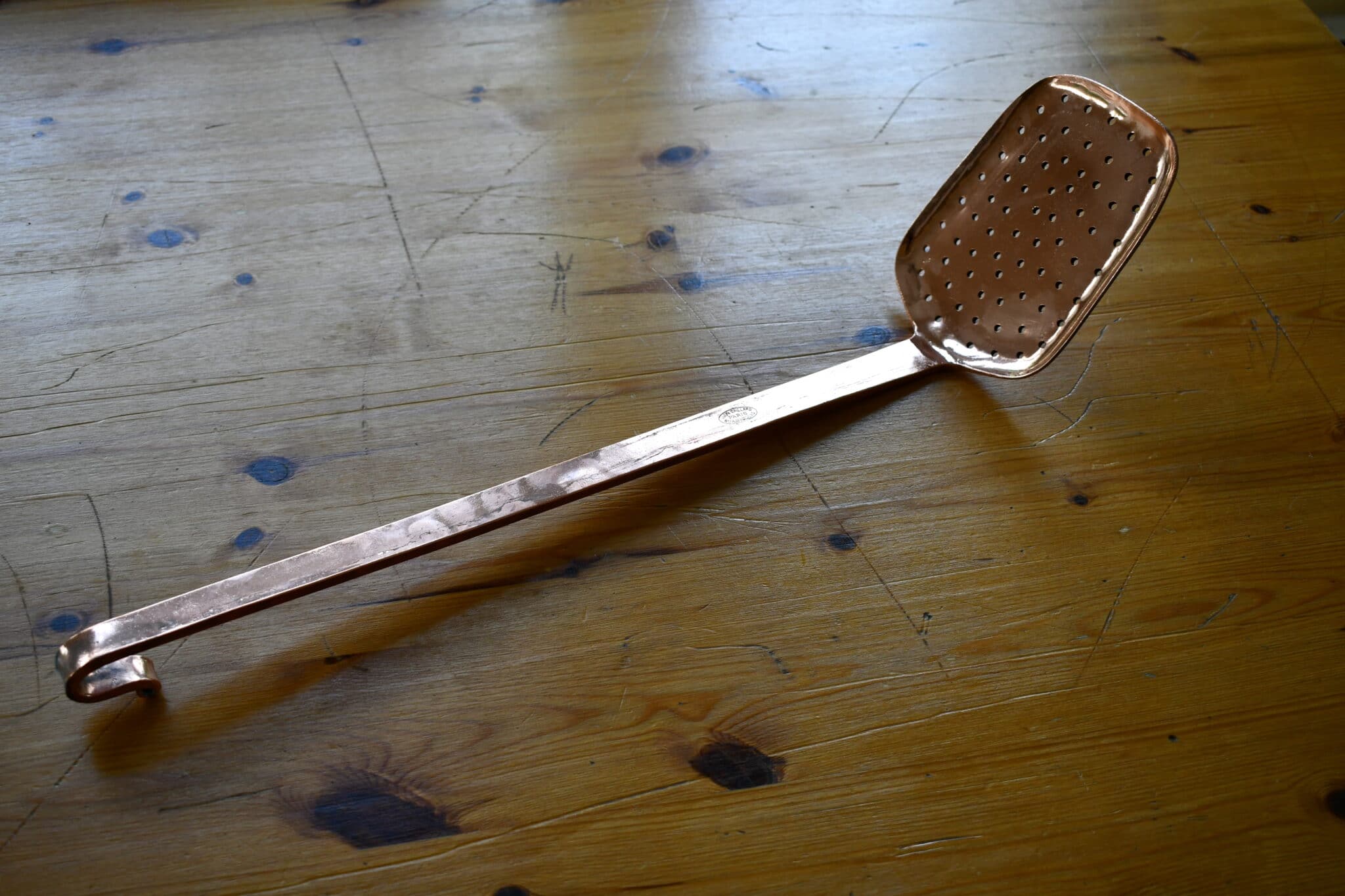
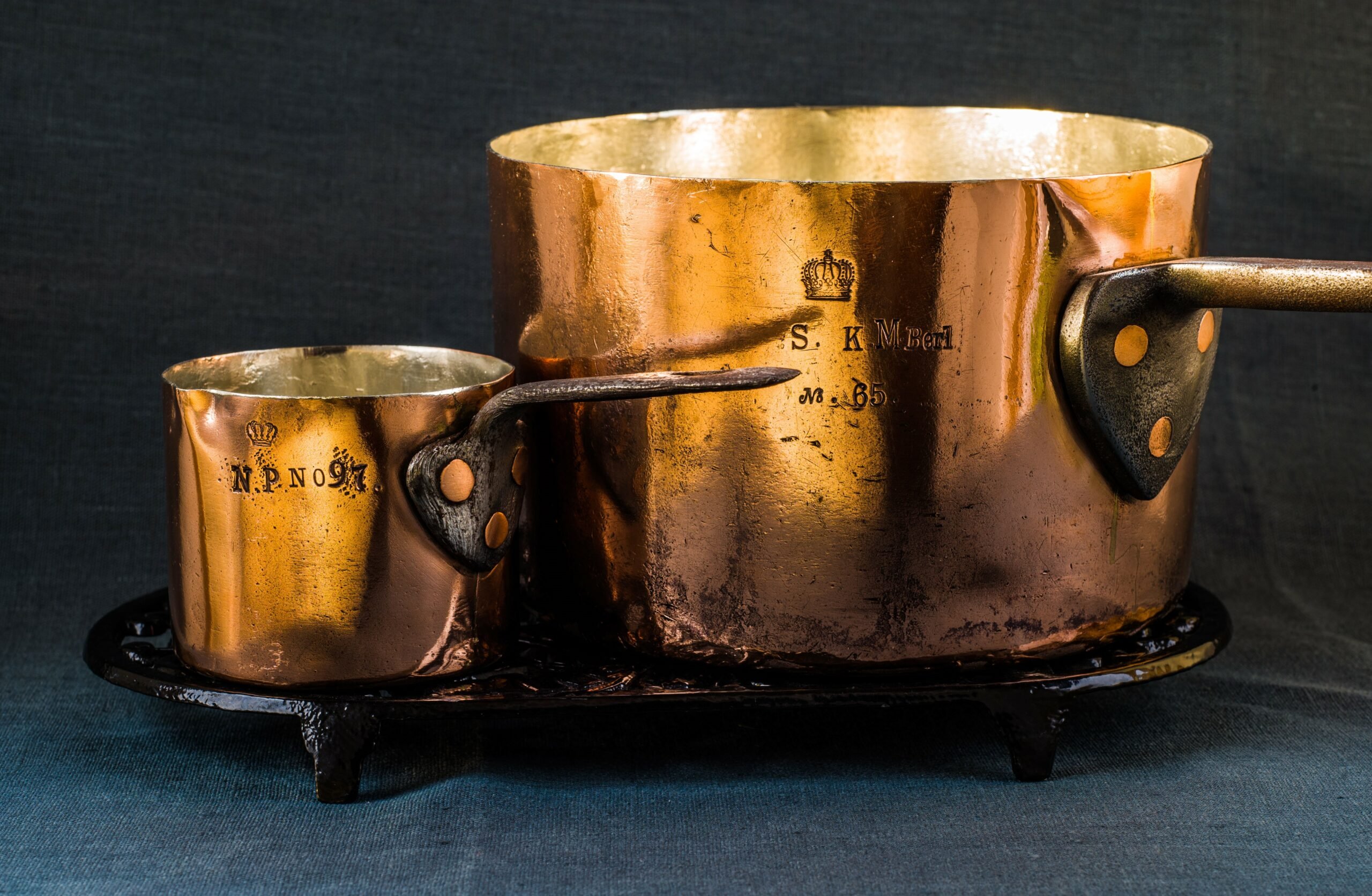
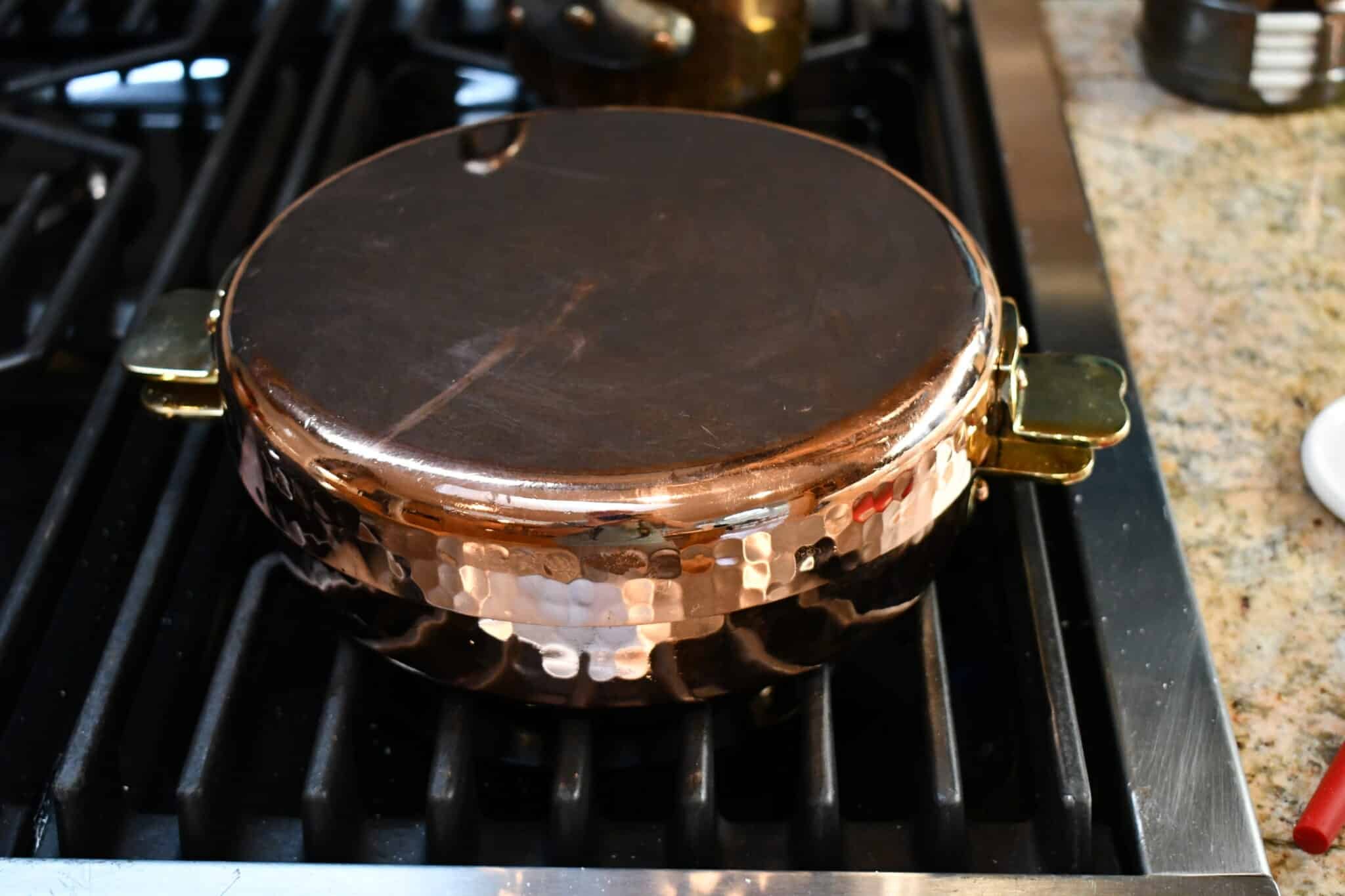
Another masterpiece from VFC! It’s great how many details have been gathered from numerous sources. I am very grateful for this work. What would the best pans and pots be without the stoves and ovens?
I think it’s important to consider not only a correlation between the choice of a particular pan for making a dish, but also the combination of stove and pan. Cooking on a wood or coal stove is different from cooking with gas or electricity. Pans and pots do not harmonize with every type of stove, at least not optimally.
Reading and especially studying how this stove works, with all its control options, gave me renewed respect for the skill and hard work of cooks (even in normal households) in earlier times. I am grateful that I was able to experience a little of this work with my grandmothers.
Extraordinary article, thank you.
I echo Martin’s proclamation – this treatise is a masterpiece! Seeing the Briffault fourneaux integrated in the various kitchen designs from the 1890 catalog… Oh, my, that got my head lost in the clouds this morning!!
With the structure of Monet’s stove, I see no possibility of loading the Four à Pâtisserie (bread oven) with coal from above. That would only be possible behind the bread oven, but that’s where the flue pipes run, which lead into the rather wide chimney. As the fireplace is positioned directly under the oven, its heat can directly heat up the bread oven via the cast-iron plate. Together with the brick walls of the oven, the heat is distributed perfectly. The space in front of the fireplace can be used as a storage area or, in the case of the heated bread oven, as a warming surface.
This oven reminds me of the stone ovens that used to be common in bakeries and can still be seen in pizzerias today. This makes it possible to achieve uniformly high heat levels, which are particularly desirable for pizzas an certain types of bread. Then 2 minutes can be enough and the dough base is nice and crispy.
If one notices closely in the kitchen example pictures, two horizontal bars are used for storing copper, a higher and a lower bar, an interesting solution. The higher bar having the hook, while the lower bar positions the pot edge away from the wall.
Superb cuisinière, a place for everything including hot water, a bread oven and warming drawer! So many of these have been broken up and sold for scrap – it is a rare item to have survived in working condition. Great post VFC!
Very nice and well researched article about a very nice stove! Thank you for that, VFC!
You can always find Briffault stoves on the French classifieds site, but I’ve never found such a beautiful example there.
I have a movie tip that fits well here:
The movie “La passion de Dodin Bouffant” (in English “The Taste of Things”) is currently being shown in cinemas. It is this year’s French entry for the Academy Awards and is set on an unspecified country estate in France at the end of the 19th century. It is mainly about the preparation of exquisite dishes from local ingredients, cooked on a stove similar to the one in VFC’s article here. The cooking is, of course, mainly done in copper, although they didn’t go too far with historical accuracy. But that doesn’t detract from the high aesthetics of the film! Highly recommended!
Thank you, Gerhard. I have heard about this movie and will definitely watch and enjoy it. For readers in Austria and Germany (possibly also Switzerland) who can receive the DF1 TV channel, I recommend a series about top restaurants (1-3 Michelin stars) and hotels in Austria. In each case, the history and development of the restaurants, the chefs’ years of training and traveling and the philosophy and working methods that developed from this are presented with historical cross-references. Of course, you also get a good insight into their kitchens and how the food is prepared and served. Naturally, only first-class, predominantly regional and organically produced food is used. At “TIAN” in Vienna, the cuisine is exclusively vegetarian and vegan (1 Michelin star, 4 toques or 98 out of 100 points from Gault Milleau). However, our nostalgic and romantic needs are hardly satisfied.